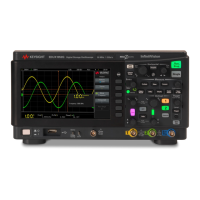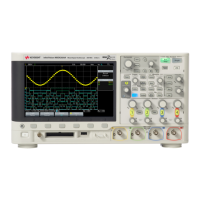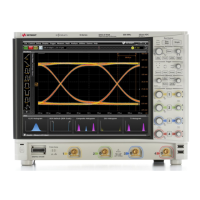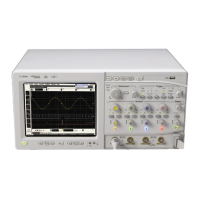32 Keysight InfiniiVision HD3-Series Oscilloscopes User's Guide
1 Getting Started
3. Horizontal scale
knob
Turn the knob in the Horizontal section that is marked to adjust the time/div
(sweep speed) setting. The symbols under the knob indicate that this control has the effect of
spreading out or zooming in on the waveform using the horizontal scale. See
Chapter 2,
“Horizontal Controls,” starting on page 45.
4. Horizontal position
knob
Turn the knob marked to pan through the waveform data horizontally. You can see the
captured waveform before the trigger (turn the knob clockwise) or after the trigger (turn the
knob counterclockwise). If you pan through the waveform when the oscilloscope is stopped
(not in Run mode) then you are looking at the waveform data from the last acquisition taken.
See
Chapter 2, “Horizontal Controls,” starting on page 45.
5. [Zoom] key Press the [Zoom] key to split the oscilloscope display into Normal and Zoom sections without
opening the Horizontal Menu. See
Chapter 2, “Horizontal Controls,” starting on page 45.
6. [Clear Display] key When you press the [Clear Display] key, acquisition data is cleared from the oscilloscope
display. See
"To clear the display" on page 126.
7. [Auto Scale] key When you press the [Auto Scale] key, the oscilloscope will quickly determine which channels
have activity, and it will turn these channels on and scale them to display the input signals.
See "Use Autoscale" on page 28.
8. [Default Setup] key Press this key to restore the oscilloscope's default settings (details on
"Recall the Default
Oscilloscope Setup" on page 27).
9. [Slope] key Press until the desired slope LED is lit. You can have an edge trigger on a rising or falling
edge. See
Chapter 10, “Triggers,” starting on page 135.
10. [Mode] key Press until the desired LED is lit (Trig'd or Auto).
When Trig'd is selected, the oscilloscope must find the trigger before saving and displaying
captured data.
When Auto is selected, if a trigger does not occur within a certain amount of time, an
acquisition is automatically saved and displayed. In Auto trigger mode, you are able to see
your signals while setting up the desired trigger.
See Chapter 10, “Triggers,” starting on page 135.
11. Trigger Level knob Turn the knob adjust the vertical level used for analog channel edge detection. See
Chapter 10, “Triggers,” starting on page 135.
12. [Force] key Press to trigger on anything and make a single acquisition.
This is sometimes useful in the Trig'd mode to view a signal when triggers are not occurring.
See
Chapter 10, “Triggers,” starting on page 135.
13. Entry knob The Entry knob is used to select items from menus and to change values. The function of the
Entry knob changes based upon the current menu and entry field selections.
Note that the curved arrow symbol next to the entry knob illuminates whenever the
entry knob can be used to select a value. Also, note that when the Entry knob symbol
appears in an entry field, you can use the Entry knob, to select values.
Often, rotating the Entry knob is enough to make a selection. Sometimes, you can push the
Entry knob to enable or disable a selection. Pushing the Entry knob also makes popup menus
disappear.
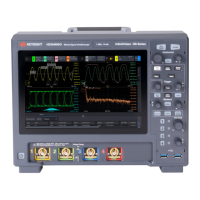
